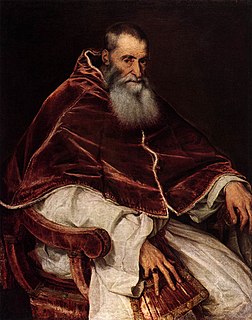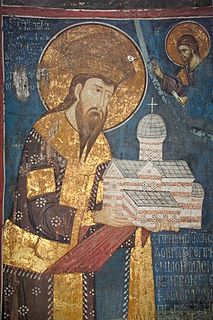
Mystras or Mistras, also known as Myzithras (Μυζηθρᾶς) in the Chronicle of the Morea, is a fortified town and a former municipality in Laconia, Peloponnese, Greece. Situated on Mt. Taygetos, near ancient Sparta, it served as the capital of the Byzantine Despotate of the Morea in the 14th and 15th centuries, experiencing a period of prosperity and cultural flowering. The site remained inhabited throughout the Ottoman period, when it was mistaken by Western travellers for ancient Sparta. In the 1830s, it was abandoned and the new town of Sparti was built, approximately eight kilometres to the east.

The Principality of Achaea or of the Morea was one of the three vassal states of the Latin Empire which replaced the Byzantine Empire after the capture of Constantinople during the Fourth Crusade. It became a vassal of the Kingdom of Thessalonica, along with the Duchy of Athens, until Thessalonica was captured by Theodore, the despot of Epirus, in 1224. After this, Achaea became for a while the dominant power in Greece.

The Asen dynasty founded and ruled a medieval Bulgarian state, called in modern historiography the Second Bulgarian Empire, between 1187 and 1256.

The Palaiologos, also found in English-language literature as Palaeologus or Palaeologue, was the name of a Byzantine Greek family, which rose to nobility and ultimately produced the last ruling dynasty of the Byzantine Empire.

Demetrios Palaiologos or Demetrius Palaeologus was a Byzantine prince and Despot. He ruled over Mesembria and Lemnos, before becoming Despot in the Morea in 1449. He remained co-ruler of the Morea along with his brother Thomas Palaiologos until he surrendered Mistras to the Ottomans in 1460. He was given lands in Thrace as an appanage by Sultan Mehmed II, which he ruled until his disgrace in 1467. Shortly after he was allowed to retire to Adrianople with his wife. He became a monk with the monastic name David after the death of his daughter Helena Palaiologina in 1469, and died in 1470.

Ivan Sratsimir or Ivan Stratsimir was emperor (tsar) of Bulgaria in Vidin from 1356 to 1396. He was born in 1324 or 1325, and he died in or after 1397. Despite being the eldest surviving son of Ivan Alexander, Ivan Sratsimir was disinherited in favour of his half-brother Ivan Shishman and proclaimed himself emperor in Vidin. When the Hungarians attacked and occupied his domains, he received assistance from his father and the invaders were driven away.

Michael Asen III, ruled as emperor (tsar) of Bulgaria from 1323 to 1330. The exact year of his birth is unknown but it was between 1280 and 1292. He was the founder of the last ruling dynasty of the Second Bulgarian Empire, the Shishman dynasty. After he was crowned, however, Michael used the name Asen to emphasize his connection with the Asen dynasty, the first one to rule over the Second Empire.

The Despotate of the Morea or Despotate of Mystras was a province of the Byzantine Empire which existed between the mid-14th and mid-15th centuries. Its territory varied in size during its existence but eventually grew to include almost all the southern Greek peninsula known as the Peloponnese, which was known as the Morea during the medieval and early modern periods. The territory was usually ruled by one or more sons of the current Byzantine emperor, who were given the title of despotes. Its capital was the fortified city of Mystras, near ancient Sparta, which became an important centre of the Palaiologan Renaissance.

Thomas Palaiologos or Palaeologus was Despot in Morea from 1428 until the Ottoman conquest in 1460. After the desertion of his older brother to the Turks in 1460, Thomas Palaiologos became the legitimate claimant to the Byzantine throne, a claim he maintained during his exile in Italy.
Matthew Asen Kantakouzenos or Cantacuzenus was Byzantine Emperor from 1353 to 1357.

Centurione II Zaccaria, scion of a powerful Genoese merchant family established in the Morea, was installed as Prince of Achaea by Ladislaus of Naples in 1404 and was the last ruler of the Latin Empire not under Byzantine suzerainty.
Sarah, Theodora or Sarah-Theodora was an Empress of Bulgaria during the Second Bulgarian Empire and second wife of Tsar Ivan Alexander of Bulgaria.
Helena Palaiologina was a Byzantine princess who married Serbian Despot Lazar Branković, who ruled from 1456 until his death in 1458. After Smederevo fell to the Ottoman Turks on 20 June 1459, she fled Serbia for the Greek island of Leukas, where she converted to Catholicism. She later became a nun, assuming the name of Hypomone.
Shishman was a Bulgarian nobleman (boyar) who ruled a semi-independent realm based out of the Danubian fortress of Vidin in the late 13th and early 14th century. Shishman, who was bestowed the title of "despot" by Bulgarian emperor George Terter I, was a Cuman, and may have been established as lord of Vidin as early as the 1270s.
John Komnenos Asen was the ruler of the Principality of Valona from circa 1345 to 1363, initially as a Serbian vassal and after 1355 as a largely independent lord. Descended from high-ranking Bulgarian nobility, John was a brother of both Tsar Ivan Alexander of Bulgaria and Helena of Bulgaria, the wife of Tsar Stephen Dušan of Serbia. Perhaps in search of better opportunities, he emigrated to Serbia, where his sister was married. There, he was granted the title of despot by Stephen Dušan, who placed him in charge of his territories in modern south Albania.
Alexander, subsequently Iskender, was the eldest son of Bulgarian tsar Ivan Shishman. Alexander was possibly made co-emperor by his father before the Ottoman conquest of the Tarnovo Tsardom in 1395. After the subjugation of Ivan Shishman's realm and his execution, Alexander converted to Islam to avoid his father's fate. He was made governor of Samsun, where he remained until 1402. From 1413 to 1418, when he was killed in a battle against a local rebel, Alexander was in charge of Smyrna (İzmir).
Anna, subsequently known under the religious name Anisia (Анисия), was the first wife of Tsar Ivan Asen II of Bulgaria and empress consort of the Second Bulgarian Empire from 1218 to 1221. She was exiled to a monastery in the beginning of Ivan Asen's reign, after he arranged his marriage to Anna Maria of Hungary. From his marriage to Anna, Ivan Asen had two children.
Dragana was a Serbian princess and the Empress consort of Bulgaria as the second wife of Ivan Shishman. She was a daughter of the Serbian prince Lazar and Milica Nemanjić.
Matthew Palaiologos Asen was a late Byzantine aristocrat and official, related to the Asen and Palaiologos dynasties.
John Doukas Angelos Palaiologos Raoul Laskaris Tornikes Philanthropenos Asen was a 14th- or 15th-century Byzantine noble child who died young.






















